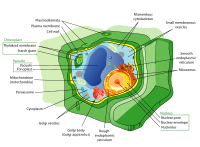 Global Information
Global InformationCytorrhysis information

Cytorrhysis is the permanent and irreparable damage to the cell wall after the complete collapse of a plant cell due to the loss of internal positive pressure (hydraulic turgor pressure).[1] Positive pressure within a plant cell is required to maintain the upright structure of the cell wall.[1] Desiccation (relative water content of less than or equal to 10%) resulting in cellular collapse occurs when the ability of the plant cell to regulate turgor pressure is compromised by environmental stress. Water continues to diffuse out of the cell after the point of zero turgor pressure, where internal cellular pressure is equal to the external atmospheric pressure, has been reached, generating negative pressure within the cell.[2] That negative pressure pulls the center of the cell inward until the cell wall can no longer withstand the strain.[1] The inward pressure causes the majority of the collapse to occur in the central region of the cell, pushing the organelles within the remaining cytoplasm against the cell walls.[1] Unlike in plasmolysis (a phenomenon that does not occur in nature), the plasma membrane maintains its connections with the cell wall both during and after cellular collapse.[1]
Cytorrhysis of plant cells can be induced in laboratory settings if they are placed in a hypertonic solution where the size of the solutes in the solution inhibit flow through the pores in the cell wall matrix.[1][3] Polyethylene glycol is an example of a solute with a high molecular weight that is used to induce cytorrhysis under experimental conditions.[3] Environmental stressors which can lead to occurrences of cytorrhysis in a natural setting include intense drought, freezing temperatures, and pathogens such as the rice blast fungus (Magnaporthe grisea).[3][4][5]
- ^ a b c d e f "3.1.4 - Turgor loss, cytorrhysis, and plasmolysis". plantsinaction.science.uq.edu.au. Archived from the original on 20 March 2018. Retrieved 3 June 2016.
- ^ Jones, Hamlyn G. (2014). Plants and Microclimate: A Quantitative Approach to Environmental Plant Physiology. Cambridge University Press. pp. 73–76. ISBN 9780521279598.
- ^ a b c Buchner, Othmar; Neuner, Gilbert (3 June 2009). "Freezing cytorrhysis and critical temperature thresholds for photosystem II in the peat moss Sphagnum capillifolium". Protoplasma. 243 (1–4): 63–71. doi:10.1007/s00709-009-0053-8. PMID 19495938. S2CID 28749980.
- ^ Moore, John P.; Vicré-Gibouin, Mäite; Farrant, Jill M.; Driouich, Azeddine (1 October 2008). "Adaptations of higher plant cell walls to water loss: drought vs desiccation". Physiologia Plantarum. 134 (2): 237–245. doi:10.1111/j.1399-3054.2008.01134.x. PMID 18494857.
- ^ de Jong, Joke C.; McCormack, Barbara J.; Smirnoff, Nicholas; Talbot, Nicholas J. (1997). "Glycerol generates turgor in rice blast". Nature. 389 (6648): 244. Bibcode:1997Natur.389..244D. doi:10.1038/38418. S2CID 205026525.